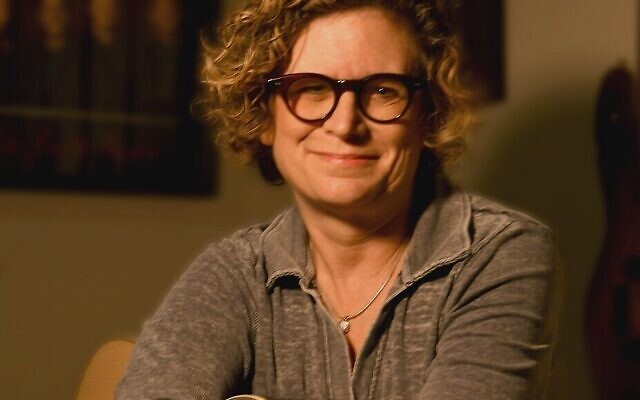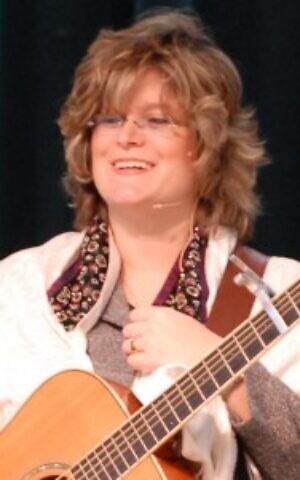Schafer Updates ‘Avinu Malkeinu’ for Diversity
Beth Schafer, Bunzl Family Cantorial Chair at Temple Sinai, has modified the traditional "Avinu Malkeinu" presentation.

No prayer signifies the arrival of the High Holy Days more than Avinu Malkeinu, with its soaring, soulful melody and its communal plea for compassion and mercy. It’s even gone viral, with Barbara Streisand’s rendition logging more than 10 million views on YouTube.
And yet, Avinu Malkeinu – Our Father, Our King – presents a yearly dilemma for Jews whose understanding of G-d transcends gender, who view G-d as neither a father nor a king.
If this describes you, maybe you’ve devised your own work-around, leaning into the music or skipping the monikers you find troubling.
But what if your seat is up on the bima? What if the words make you uncomfortable, but your actual role is to lead the congregation in song and prayer?
“I truly feel that my job is to sing with a full heart,” says Beth Schafer, the Bunzl Family Cantorial Chair at Temple Sinai in Sandy Springs. “If I want the congregation to feel the liturgy in their hearts, I have to sing it and feel it in my own heart.”
But about six years ago, that had begun to present a real problem for Schafer. After more than two decades leading congregations in Avinu Malkeinu, she’d come to the realization that the High Holiday’s central invocation does not, in fact, reflect her own personal understanding of G-d. The Hebrew of the patriarchal words, she says, started “poking through.”
“There’s been a cognitive dissonance. You know, ‘Don’t think about it. Don’t think about it,’” she says, explaining her own ruminating work-around, “because the music is so endearing. We’re just going to ignore the words. Just go with it. Because that’s what we do.”
Suddenly, Schafer couldn’t just go with it. “What about people who are new to Judaism? Who are choosing Judaism?” She thought about younger congregants learning about Judaism’s values and ethics. “What about our children? What do we tell them when we’ve enshrined this text? How do we defend it? Do we just say we just go with it because we liked the music? That’s the question I asked myself.”
And she’s not alone. Rabbi Dalia Marx, PhD, is a professor of liturgy and midrash at the Jerusalem campus of Hebrew Union College–Jewish Institute of Religion. Her eight-year-old essay entitled, “What Are We to Do With Problematic Liturgical Passages?” specifically mentions Avinu Malkeinu.
“Carried along by the wave of the haunting melody, we sometimes forget that Avinu Malkeinu contains some difficult challenges,” Marx writes. She cites Rabbi David A. Teutsch, PhD, who wrote, “Perhaps more than any other prayer, Avinu Malkeinu invokes the image of a long-bearded king sitting in judgment upon his throne. Some are struggling to escape from the transcendent imagery of G-d,” Teutsch writes, “and replace it with the divine within. Some have trouble with the maleness in the image.”

Schafer says, “It’s great to be a Reform Jew. Because we do have the liberty to visit and revisit and change with our times in a respectful way.” She mentions changes in the Amidah, the Reform Movement instituted in the 1980s, adding the names of the matriarchs Sarah, Rebecca, Leah and Rachel.
Of this change, many Conservative Jews were critical. “No sensible person denies the importance of the matriarchs,” Rabbi Jules Harlow wrote in 1997. “The problem with the liturgical change in this blessing is at least twofold. It violates the liturgical and literary integrity of the classic text of the blessing, and it breaks the close link between the language of the Bible and the language of the prayer book.”
It’s not just the Amidah. In Reform shuls, Miriam’s name accompanies Moses in the Mi Chamocha. Progressive Jews have traditionally welcomed change. But Avinu Malkeinu has stubbornly remained untouched. Schafer, a classically trained composer with seven albums of Jewish music to her name, decided it was time to try.
She says she knew it wouldn’t be as simple as updating the words and leaving the beloved melody alone. “The music is so ingrained in our Jewish identity and how we experienced the Holy Days.” To think that she could write her own version, Schafer says, was the height of chutzpahdik. “I mean, I even said that to myself and I’m sure other people are saying it as well.”
Rather than the words Avinu Malkeinu, she decided upon M’kor Hachayim, “Source of Life,” words that the Sinai clergy team have been using for a few years when the prayer is spoken. The rest of the text, she left unchanged. Next, she tackled the music.
Her first two attempts wound up in the trash. After her third, she says, “I thought this is it, this is the one.” She chose a similar tempo to the Max Janowski composition Streisand made famous, 55 beats per minute, with a slow, relaxed heartbeat. “I chose pensive, pleading minor harmonies, but also hopeful, major ones.” She humbly believes it’s among her best work.
Schafer will present it to her Temple Sinai congregation this Kol Nidre, but will still sing Avinu Malkeinu at other services. “(The traditional version) takes people back to all the Holy Days they experienced. It makes them remember the people who are no longer standing with them at the New Year,” says Schafer. “It goes straight to the heart and the soul of those who are really trying to pray during the Holy Days and so I am continuing to sing it. But I wanted to offer something to sit next to it that is more in step and aligned with what we’re trying to do with our language.”
In June, Schafer performed M’kor Hachayim at the American Conference of Cantors Convention in San Diego. Clergy from Los Angeles, Chicago, New York, Miami, and more than 20 other congregations now plan to include it in their High Holiday services this year. Many came up to her after hearing her perform it and said, “It’s time.”
Schafer says she understands not everyone will embrace it. “I would imagine that people are going to fall on both sides and that’s okay. But I hope that it inspires conversations about how we express the name of G-d and how all are represented. And, if my piece of music can do that, I will be proud and grateful.”



comments